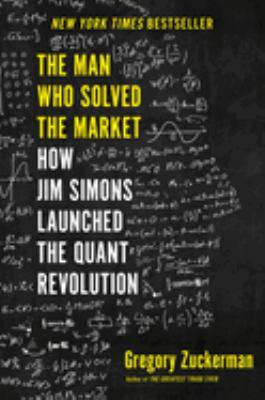
The man who solved the market : how Jim Simons launched the quant revolution
Available Copies by Location
| Location | |
|---|---|
| Community Centre | Available |
Other Formats
Browse Related Items
| Subject |
| Simons, Jim. Capitalists and financiers > United States > Biography. Investments. |
| Genre |
| Biographies. |
- ISBN: 9780735217980
-
Physical Description
print
xx, 359 pages : illustrations ; 24 cm - Publisher [Place of publication not identified] : [publisher not identified], 2019.
Content descriptions
| Bibliography, etc. Note: | Includes bibliographical references and index. |
Additional Information

Kirkus Review
The Man Who Solved the Market : How Jim Simons Launched the Quant Revolution
Kirkus Reviews
Copyright (c) Kirkus Reviews, used with permission.
Accessible if sometimes-turbulent portrait of "arguably the most successful trader in the history of modern finance."James Simons, a math professor, founded Renaissance Technologies in 1982 and has since leveraged a battery of other mathematicians and machines to earn more than $7 billion per year in market gainsa sum that, Wall Street Journal writer Zuckerman (The Frackers: The Outrageous Inside Story of the New Billionaire Wildcatters, 2013, etc.) notes, is greater than the annual revenue of Levi Strauss and Hyatt Hotels. The firm does this with a staff that's markedly smaller than the usual investment house, all of them "quants" devoted to a scientific approach to playing the market. Whereas investors such as Warren Buffett followed a "value" strategy that, as the textbooks have it, "recommended buying when prices cheapened and taking money off the table when prices richened," Simonswho had earned his wings developing algorithms to break Soviet codes in the Cold Warfollowed trends closely, amassing historical price information and hiring people devoted to "foraging and cleaning data the rest of the world cared little about." Data can be cooked, of course; Zuckerman writes that Simons was impressed by the figures a rising investment manager named Bernard Madoff was posting, though he pulled his funds when he came to suspect them well before Madoff's vast Ponzi scheme was exposed. Simons' devotion to numbers and algorithms did not rule out gut instincts, as with the near-ruinous market crash of 1987, though, as Zuckerman notes, the quants did better than their nonquant counterpartsone reason why the quants now rule the market. Of more than passing interest are the liberal Simons' dealings with partner Robert Mercer, who applied quant methods to politics and came up with the likes of Donald Trump and Steve Bannon, a decision that brought enough heat on the house to force Mercer's resignation.Worthwhile reading for budding plutocrats and numerate investors alike. Copyright Kirkus Reviews, used with permission.

Publishers Weekly Review
The Man Who Solved the Market : How Jim Simons Launched the Quant Revolution
Publishers Weekly
(c) Copyright PWxyz, LLC. All rights reserved
A gripping biography of investment game changer Jim Simons arrives from journalist Zuckerman (The Greatest Trade Ever). With little experience in business before he started trading at age 40, Simons made for an unlikely innovator. Nonetheless, this book reveals, Simons created the "greatest money-making machine in financial history" with his company, Renaissance Technologies, founded in 1982, and particularly with the firm's flagship Medallion hedge fund, founded in 1988. Showing a flair for the surprising and dramatic statement, Zuckerman proposes that Simons eclipses the more famous likes of Warren Buffett and George Soros as "arguably the most successful trader in the history of modern finance," with a net worth of about $23 billion. A theoretical mathematician and former math professor, he was the first to take a mathematical, data-driven approach to investing. Gambling that computers using predictive mathematical models could beat human judgment, he won, and changed the industry. Zuckerman skillfully recounts Simons's backstory--his comfortable childhood in Newton, Mass.; his time spent crafting code-breaking algorithms for the National Security Agency during the 1960s--the salient details of his revolutionary work, and his failures as well as his successes. With a potential recession looming, readers looking to understand how the economy got where it is should eat this up. (Nov.)


